2009 Ford F-150 – Click above for high-res image gallery
It's been said far too often that timing is everything. Sometimes a product comes to market before the market is ready, such as when the Diamond Rio MP3 player debuted a decade ago. Other times, the market moves on before a product arrives. For Ford and Chrysler, the latter rings truer than ever in late 2008. Both companies opened the year with splashy introductions of all-new redesigned full-size pickup trucks at the Detroit Auto Show. Those events were quickly followed by an utter collapse of demand for the entire segment. As U.S. gas prices surged to $4 a gallon and beyond, sales of big trucks dropped by nearly half.
When the last couple of generations of the F-150 launched, Ford spent months building extra trucks on overtime to ensure it had enough stockpiled inventory while it re-tooled factories for the new models. This time around, Ford had so many unsold units of the current F-150 sitting on dealer lots that the Dearborn brand was forced to delay Job 1 for three months while the old stock was cleared out with heavy incentives. That time has now arrived, so Ford invited the media out to its Michigan Proving Ground in Romeo, MI to try out the newest edition of the F-150 that, until last spring, had been the top selling vehicle in America ever since the age of the dinosaurs. Read on to find out if the F-150 is still the leader.
Photos Copyright ©2008 Sam Abuelsamid / Weblogs, Inc.
______________________________________________________
This post has been Twittered. Click here to follow Autoblog on Twitter
In introducing the new F-150 to the gathering, Ford truck marketing manager Doug Scott began with the refrain "Capability Matters!" in discussing the newly enhanced capabilities of the the truck. Certainly no one could argue with that statement. The real question though is not whether it matters, but rather what capabilities do buyers actually need? As gas prices have risen this year, more and more people who were considering full-size trucks have dramatically revised their requirements for what they need in a vehicle. Non-commercial buyers have been deciding in droves that they don't actually need a truck.
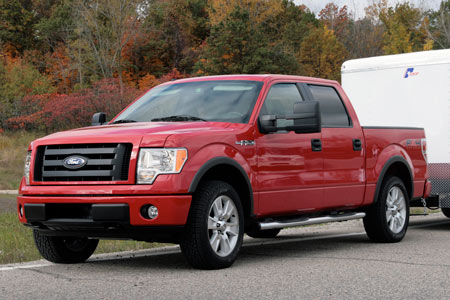
In recent years, half of all light-duty trucks were bought for personal tow-haul use with another 20% being for image, according to Scott. In 2008 that has dropped to a combined 60 percent with the rest being used as work trucks. Since it takes 4-5 years to bring a product like this to market, Ford started work on the new F-150 when the segment was at its peak. Now much of the new truck's enhanced capability might go to waste. Scott did bring up an interesting point during his presentation: while many people who had bought F-150s for personal use have moved back to more reasonable vehicles (he didn't actually use that language, but I'm making a point here), the F-150 has also seen new customers. Those are buyers who previously went for the F-250/350 Super-Duty trucks but overbought.
In the first half of 2007, 5.5 percent of previous Super-Duty buyers moved down to the F-150 after realizing they had bought too much truck. In the first half of this year, that number jumped to 9 percent. Scott noted the gap in areas like towing capability between light and heavy duty models for competitors making the step down more difficult. With towing capacities of up to 11,300 lbs for longer wheelbase versions of the F-150, Scott feels the truck is well positioned to catch down-sizing over-buyers.
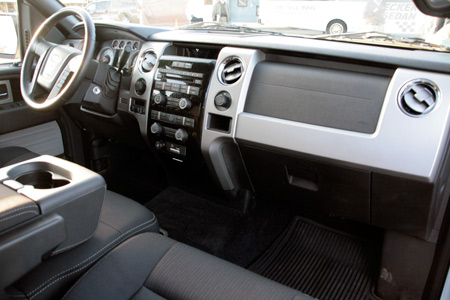
When we got out into the trucks, a couple of things became readily apparent. Like the competition from Chevrolet and Toyota, the interior of the more pedestrian variants of the F-150 is dominated by hard plastics on the doors and dash. The designs and textures are pleasant enough and everything is fairly well laid out. In fact, the materials are generally more attractive than those in the Toyota Tundra in particular. The steering wheel has a pleasantly thick rim to grab. The seats in particular have also been dramatically improved with more lateral and back support and a longer, lower seat cushion.
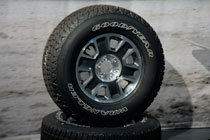
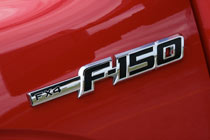
The revived FX4 model that we drove first is the designated off-road variant and reverses the trend to ever larger wheels and tires. The FX4 is available with a 17-inch wheel and tire package specifically for those who intend to get off the pavement. The 17-inch wheels allow for more sidewall on the tires, which makes it easier to climb over back trails or Michigan's damaged roads. On the drive out to the off-road area of the 4,000 acre proving ground, the F-150 was quiet and refined even with the Goodyear Wrangler LT tires. The ride was comfortable and well damped and the steering effort was nicely weighted.
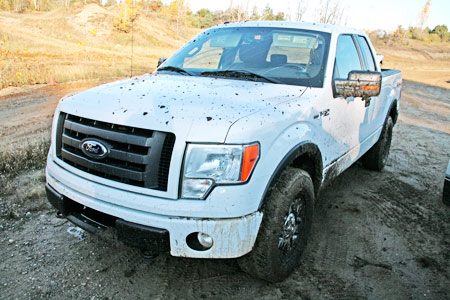
There was some heavy rain the night before our drive and the trail was muddier than usual, and areas that had a significant amount of clay got particularly slick. However, the FX4 proved remarkably capable when we got into the mud. Even in the area known as "cat-tail swamp" with the transfer case in 4X4 low range and the electronic locking differential engaged, the F-150 was able to pull itself clear unless you got into the absolute worst stuff. Engaging 4-low requires coming to stop, putting the transmission into neutral and turning a knob. Going from two-wheel drive to four-high, however, can be done on the fly. Locking the rear differential can be done at speed by simply pulling out the transfer case selector knob. On our second pass through the swamp, the F-150 powered up over the hump into the swamp on the other side and promptly impaled a fog light on a branch that was stuck in the ground. The truck kept on going with it's new-found tusk until one of the support staff waved us down to remove the branch from the now empty fog-light socket.
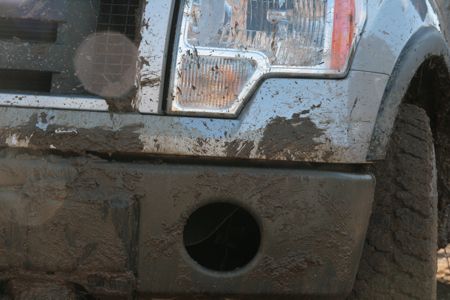
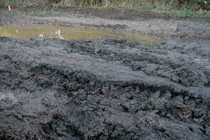
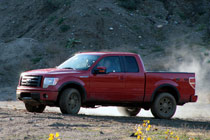
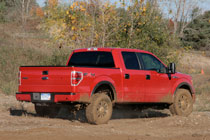
Through some very tight and twisty areas and other rough terrain, the F-150 comported itself very well. There were never any signs of flex or groan from the chassis and the suspension proved very resilient. The body stayed vertical most of the time as the suspension articulated over the trail, minimizing the side to side rocking on the inside.
When we moved over to the trailer towing exercise, Ford had lined up a group of competitors consisting of the Chevy Silverado, Toyota Tundra and the new 2009 Dodge Ram. Each had a 7,000 lb trailer hooked up, the weight being determined by the lowest common denominator Dodge and its 7,300-lb tow limit. The new coil spring suspension of the Ram may be good for on-the-road ride quality, but apparently hampers towing capacity even with the optional 5.7L HEMI – but we'll come back to that in a moment.
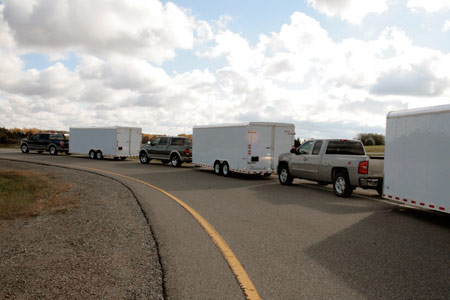
The towing test was run over a 2.5-mile loop that included up and down hill grades and a number of corners. The first section included a wide open throttle climb to 55 mph, a task the F-150 and Tundra handled with comparative ease. Ford's new 6-speed automatic transmission is an upgraded version of the unit that debuted a couple of years ago in the Expedition, and one of its more interesting features is an integrated trailer brake controller.
Not only is the unit a factory option integrated into the dash, but it's also integrated with the stability control system that includes trailer sway control. By incorporating it into the slip control system, the trailer brakes can be blended seamlessly with the vehicle brakes.
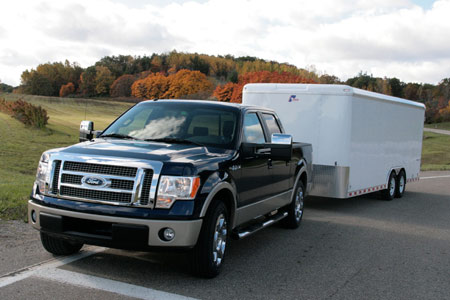
Ford is also the only truck maker to include a roll sensor in its stability control system. In addition to body, the roll sensor helps detect banking in the road so that offsets can be calculated for lateral accelerometer and yaw rate signals, which enhances the behavior of the stability control. Another feature of the F-150 is a new tow/haul mode. When engaged, a quick tap of the brake pedal while running downhill brings on a downshift to aid engine braking. The overall effect of all this gadgetry is a complete lack of drama when towing a 7,000-lb trailer.
The Chevy and Toyota trucks were both equipped with after-market trailer brake controllers. The systems work independently of the vehicle brakes and often led to rough and uneven braking at low speeds. The Toyota also exhibited a tendency toward fore-aft porpoising when running on level ground at 45-50 mph, which is apparently related to flexing of the chassis and rear suspension.
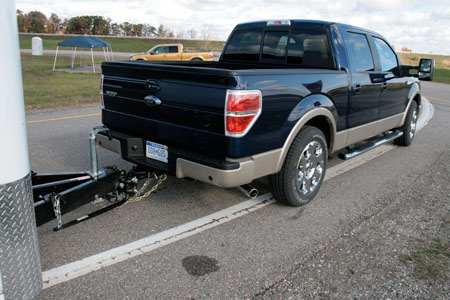
The Ram and Silverado also had trouble climbing a 4% grade with the trailer. With its 5.7L HEMI and 5-speed automatic transmission, the Dodge had plenty of grunt, but the gap between 2nd and 3rd gears was apparently just too much. The revs dropped out of the torque band's sweet spot, and where the Ford was reaching over 55 mph, the Ram got to just 45 and wouldn't accelerate any more until we crested the hill. Similarly, the Silverado equipped with a 5.3L V8 and four-speed automatic had trouble climbing. A similar Silverado, however, with GM's new six-speed auto would have no such difficulty.
With all its cool new features, like the side step and rear tailgate step, the 2009 Ford F-150 is certainly not short on capability. It has plenty of towing and payload capacity and feels solidly built thanks to plenty of high strength steel in the chassis and cab. It's poised to be the top of its class. Unfortunately for Ford, that class is shrinking and it's not yet clear when it will stop. If you need all the new capabilities that the '09 F-150 offers, it may well be the best choice. However, as we alluded to earlier, the real question is what capability do you really need?
Photos Copyright ©2008 Sam Abuelsamid / Weblogs, Inc.
You can find more information and specs on the 2009 Ford F-150 over at AOL Autos.

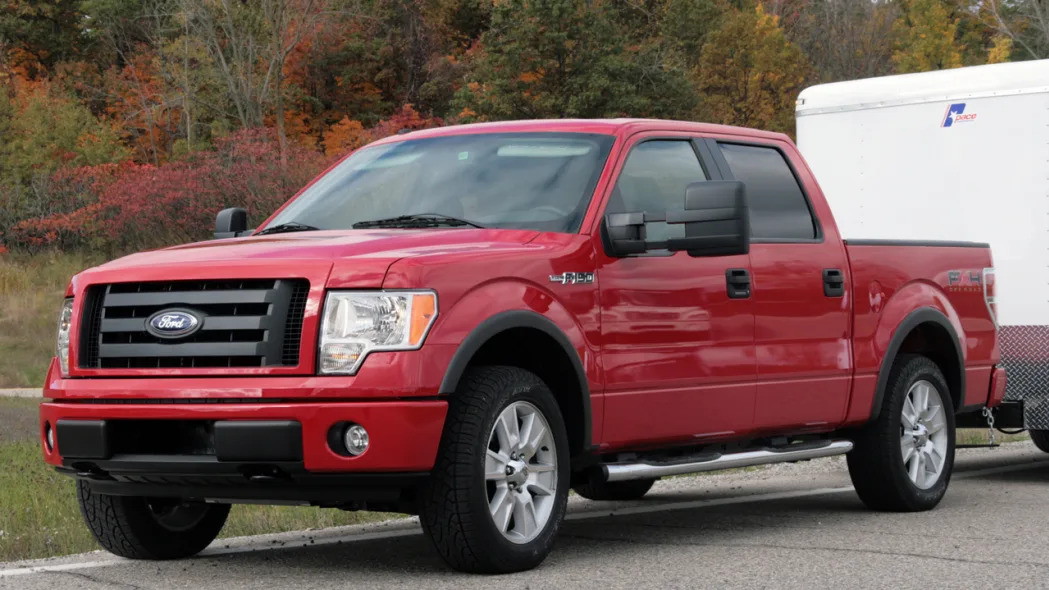

Sign in to post
Please sign in to leave a comment.
Continue